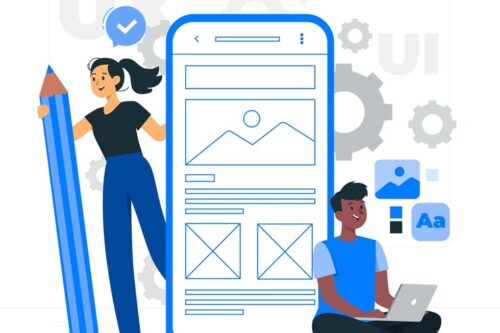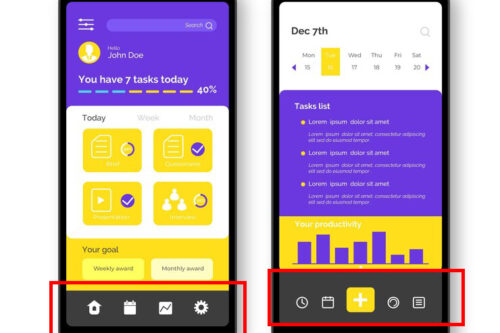What is the design of the user experience?
User experience is the value that it gives a user when they use your product.
Developing the user experience to the level of customer satisfaction is not the responsibility of a person or team, but rather the vision of the company.
How important is user experience?
The brilliant design of the user experience not only highlights and promotes your product but also becomes an essential part of the building and increases customer confidence.
A great product or persuasive content without an engaging user experience can affect an organization’s ability to achieve its business goals.
The best approach to design a user experience.
Designing good user experience is always part of the product development process.
Interact with users to create a unique combination of structure, content, and user experience that will achieve the desired goals effectively.
This approach enables you to create clean, simple, intuitive, flexible, and attractive designs, providing a WOW experience for your users, and therefore setting you apart from your competition.
User experience design process
The user experience design process is an iterative method that helps you constantly improve and refine your designs.
In this process, you go through several stages frequently while evaluating your designs at each stage.
Each stage includes stakeholders in your organization who are involved in the process to make your products highly efficient and usable.
The design process includes the following six stages.
Stage 1: Understand – Requirements
Stage 2: Research
Stage 3: Gathers Ideas
Stage 4: Design
Stage 5: Implement
Stage 6: Evaluate
Stages of the UX design process
Below are the details that highlight the stakeholders involved, the activities being carried out and the results achieved during each stage of the process.
Stage1: Your understanding
Design solves a problem. To provide a solution, you must first understand the problem.
To analyze requirements, follow industry standard user search methods, including contextual and one-on-one interviews, while monitoring users in a real-world environment.
Conduct brainstorming sessions with customers and show them your current products (if any) to get their feedback.
The business manager is the role in an organization that works directly with the clients and gets the requirements from them. The design team can work closely with the business manager to understand users and their needs.
This knowledge of the user and their environment helps you provide clear direction for your design.
Concerned parties
- Designer Team
- Business manager
- Production manager
Activities
- Know, speak, monitor and understand users in your environment.
- Analyze the requirements to understand and clarify them.
- Define user personalities and use cases.
The results
- User personalities
- User stories
- Use cases, user flows
Stage 2: Research
Research is an essential basic step in designing a user experience.
The design team is researching to explore how the outside world works on these features.
Monitor the latest user interface trends, design principles, and current user experience guidelines.
As you do your research, start thinking about possible designs and options to provide the desired experience.
Concerned parties
- Designer Team
Activities
- Examine the study plans of the competitors.
- Find similar features in the world
- Analysis of the latest UI / UX trends and design principles and rules.
- Check your UX guidelines
The results
- A collection of ideas and materials with which you can build your real design work
Stage 3: Sketch
This stage includes the user interface definition of the required function. The design team leads this activity that is based on the last two stages of the process.
Draw graphics on paper, whiteboard flow, and patterns to share your thoughts with stakeholders.
This same stage is an iterative process.
The testing and evaluation of wireframes is part of this stage. The design team builds prototypes and engages with stakeholders to obtain their input.
Throughout the process, it is important to keep in mind your goal: to create a usable design for maximum user satisfaction.
Concerned parties
- Designer Team
- Product managers
- Technical experts
Activities
- Brainstorm and work on basic charts.
- Brainstorming sessions with stakeholders to get feedback from a technical perspective.
- Repaint drawings and retest with stakeholders
The results
- Sketches
- Tires and cable models
- User flows
- Create wire mesh
Stage 4: Design
Now that you have finished planning and transmitting the required interface with you, the next step is to work on the final graphics.
Convert prototypes and wireframes to cool photos using the design and styles applied to them.
The preparation and sharing of design specifications (principles, guidelines, colours, printing, icons) for the development team are also part of this stage.
Concerned parties
- Designer Team
- Product managers
- Business manager
- Technical experts
Activities
- User interface photography design
- Determine the final topic, specifications and guidelines required for implementation
- Design of icons to show on screens
- Sessions with interested parties to obtain their comments from a commercial and technical perspective.
The results
- Design Photos
- Detailed design specifications, such as colours, appearance, patterns, and instructions.
- Icons
Stage 5: Implementation
Since technical people are involved in the early stages of the process, they can begin implementation during the design phase.
The development team first creates the final function and connects it to the user interface when they get design elements.
It is better than involving the design team in this step to assist in the development stage. During implementation, it is possible to increase the need for minor design changes.
Concerned parties
- Development team
- Designer Team
Activities
- Perform background and front-end functions
The results
Enhanced user interface with full functionality, theme tracking, and design expertise. Programming and implementation functions.
Stage 6: Evaluation
By implementing the product features, the final product is evaluated based on several factors:
- What if the system is usable?
- Is it easy to use for the end-user?
- Is it flexible and easy to change?
- Does it provide the required solution to user problems?
- Does the product have the credibility that makes someone want to use it because of the experience it provides?
Concerned parties
- Designer Team
- Production manager
Activities
- Go through the flow and feel the experience.
- Make a comparison between the implementation and a specific interface
The results
- User Comments
- User interface audit reports
- The identified areas where improvement is required
After this last stage, the process will repeat depending on the required changes, you can go to stage 2, 3 or 4.
The process continues until the required experience and customer satisfaction are achieved.
Gain a better understanding of the UX design process and other related topics:
conclusion
The incredible user experience can only be provided by following an iterative design process.
All the main stakeholders of your company contribute to the process by performing their functions and duties. This is the only way you can keep your current users and attract new users in this competitive world.


